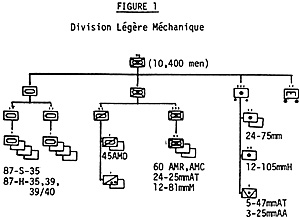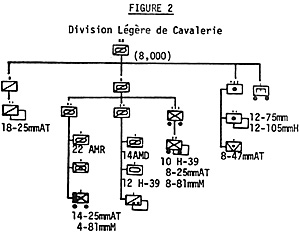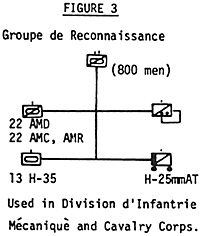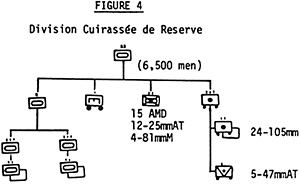Armored Units
During World War I the French Army formed several armored car regiments, the first French armored units. The only one to see action in 1940 was Groupe 97 (Legion Etrangere). This was formed in February 1940, with two escadrons from each of the two Legion mechanized cavalry regiments in North Africa. In March 1940, Groupe 97 was transferred to France. Most sources agree that Groupe 97 was an independent unit equipped with AM Whites, however Windrow states that while it was motorized it was not equipped with any armored vehicles and served as 7th North African Division's cavalry regiment. The descriptions of its last battle on June 9 specifically mention "old armored cars."
The next oldest French armored units were the Bataillons de Chars de Combat and the smaller Compagnies Autonomes de Chars de Combat, dating from 1916. The bataillons were classified as BatailIons Organiques, assigned to the Corps and Armees for direct infantry support, except for those few equipped with Chars B, D-2, and H-35 assigned to the DCRs. The compagnies were also assigned to infantry support, except for the 345e which was equipped with Chars D-2 and assigned to the 4e DCR. By May 1940, 41 Bataillons Organiques and 11 Compagnies Autonomes were available including those in the colonies. Generally the Bataillons Organiques were grouped in pairs for administrative purposes, i.e., the 38e and 13e Bataillons equipped with H-35s and H-39s were under the 519e Groupe de Batallions de Chars, assigned to the 1re Armee. The army assignments and equipment of the various Bataillons Organiques on May 10, 1940, are shown in Table 2. Other Bataillons Organiques were incorporated in divisional formations during May and June, such as the 4e DCR and the 7e DLM. During the campaign the 1re and 2e Bataillons Polonaises de Chars de Combat, Polish exiles in R-35s and R40s, fought as part of the 10e Brigade Motorisee Polonaise. Three Bataillons Organlques were sent to France from Tunisia in early June: 61e, 65e, and 6.7e with Chars D-1.
 The first division-sized French armored formation was the Division Legere Mecanique (DLM). The 1re DLM was established in 1934 one year before the first German panzer division. The 29e DLM was formed in 1938. The 3e was organized in August 1939, but was not ready for combat until early May 1940. A fourth DLM was being assembled in May 1940, but the material was used instead to rebuild the shattered 1re and 4e DLC in early June 1940, as the 4e and 7e DLM respectively. The DLM consisted of a tank brigade (Brigade de Combat), a mechanized brigade (Brigade de Decouverte), artillery and engineers (Figure 1). The 3e DLM had 60 additional H-35s or H-39s in place of the 60 AMRs and AMCs in the Brigade de Decouverte because AMCs and AMRs were not available. The 70 DLM received additional tanks and motorized the surviving horse elements of the 4e DLC. The 7e DLM was brought up to strength by the addition of a newly formed Bataillon Organique equipped with R35, R-39, and R40 tanks, and was ready for use June 5, 1940. The 4e DLM never exceeded brigade size, being essentially the 1re DLC's motorized cavalry brigade and division artillery. The 4e DLM was ready for action June 10.
The first division-sized French armored formation was the Division Legere Mecanique (DLM). The 1re DLM was established in 1934 one year before the first German panzer division. The 29e DLM was formed in 1938. The 3e was organized in August 1939, but was not ready for combat until early May 1940. A fourth DLM was being assembled in May 1940, but the material was used instead to rebuild the shattered 1re and 4e DLC in early June 1940, as the 4e and 7e DLM respectively. The DLM consisted of a tank brigade (Brigade de Combat), a mechanized brigade (Brigade de Decouverte), artillery and engineers (Figure 1). The 3e DLM had 60 additional H-35s or H-39s in place of the 60 AMRs and AMCs in the Brigade de Decouverte because AMCs and AMRs were not available. The 70 DLM received additional tanks and motorized the surviving horse elements of the 4e DLC. The 7e DLM was brought up to strength by the addition of a newly formed Bataillon Organique equipped with R35, R-39, and R40 tanks, and was ready for use June 5, 1940. The 4e DLM never exceeded brigade size, being essentially the 1re DLC's motorized cavalry brigade and division artillery. The 4e DLM was ready for action June 10.
In the spring of 1940, a Polish DLM was being formed with survivors of the Polish 10e Brygada Kawalerfi Mechanizowanei. This unit was committed to battle incomplete as the 10e Brigade Motorisee Polonaise.
 Lighter versions of the DLM were formed in the winter of 1939 and spring of 1940. These five partially mechanized Divisions Legers de Cavalerie (DLC) were formed from the three horse cavalrY division in France and several mechanized cavalry regiments. In each DLC a horse brigade was paired with a mechanized brigade (Figure 2). Another DLC, the 6e, was formed in North Africa to a different establishment.
Lighter versions of the DLM were formed in the winter of 1939 and spring of 1940. These five partially mechanized Divisions Legers de Cavalerie (DLC) were formed from the three horse cavalrY division in France and several mechanized cavalry regiments. In each DLC a horse brigade was paired with a mechanized brigade (Figure 2). Another DLC, the 6e, was formed in North Africa to a different establishment.
The mission of both the DLC and the DLM was the traditional cavalry role of reconnaissance and screening the main infantry army. Additionally, they were to exploit breakthroughs achieved by the infantry and the Bataillons Organiques.
 Smaller mechanized cavalry units, Groupes de Reconnaissance, were attached to the seven Divisions d'Intantrie Mecanique (DIM) and the Corps de Cavalerie to perform tactical reconnaissance (Figure 3). The DIMs were motorized versions of the active infantry divisions. The DIMs were to be used as mobile reserves and with the DLCs and DLMs in exploiting breakthroughs.
Smaller mechanized cavalry units, Groupes de Reconnaissance, were attached to the seven Divisions d'Intantrie Mecanique (DIM) and the Corps de Cavalerie to perform tactical reconnaissance (Figure 3). The DIMs were motorized versions of the active infantry divisions. The DIMs were to be used as mobile reserves and with the DLCs and DLMs in exploiting breakthroughs.
 The infantry formed no division-sized armored units until after the outbreak of war in September 1939. At that time the 1re Division Cuirasse de Reserve (DCR) was formed with four bataillons of Chars B (formally Bataillons Organiques), two bataillons of infantry in armored carriers, engineers and artillery.
The infantry formed no division-sized armored units until after the outbreak of war in September 1939. At that time the 1re Division Cuirasse de Reserve (DCR) was formed with four bataillons of Chars B (formally Bataillons Organiques), two bataillons of infantry in armored carriers, engineers and artillery.
In January 1940, the 1re DCR split to form a second DCR. Because sufficient Chars B were not available each division received two bataillons of Chars B and two of H-39s (Figure 4). The 3e DCR lacked trucks and recovery vehicles, six Chars 8, half the armored carriers for the infantry bataillon, AMDs, motorcycles and the engineer company. The artillery regiment assigned to the 3e DCR was still forming and lacked prime movers.
The 4e DCR was formed under then Colonel De Gaulle from May 13 on, literally on the road to battle. It was at best an ad hoc formation, with the units assigned changing daily (Table 3). A proposed fifth DCR was not formed, the material reserved for it being fed into the other DCRs as replacements.
In Action May-June 1940
When the German attack in the West began on May 10, 1940, the three DLMs and 1re and 4e DLCs advanced into Belguirn to screen the movement of the French into the Dyle Line and southern Holland. The 7e Armee, on the far left of the French line, between the BEF and the sea, was led by the 1re DLM across Belgium into Holland. The Corps de Cavalerie encountered the XVI Panzerkorps and was forced to give ground. Meanwhile the 1re and 4e DLC covering SP Armee to the right of 1re Armee, and the 209 and 5e DLC screening 26 Armee met the main German thrust. Five of the DIMs followed the DLMs into Belgium, one was with 9e Armee and one was in reserve with the three DCRs. The DCRs were fed in piecemeal from May 14 to shore up the 9e and 2e Armees, with the 1re DLM which had been withdrawn from Holland. The 1re DCR, 1re and 4e DLCs, and the 5e DIM were destroyed in the collapse of 9e and 2e Armees. The 1re DLM, and the 2e and 3e DCRs were dismembered and dispersed.
As the German panzers raced to the sea across the rear of the 1re and 7e Armees and the BEF, the ad hoc 4e DCR had some success in several limited counterattacks supported by the surviving DLCs.
| Table Three: Units Assigned to the 4e DCR | ||
|---|---|---|
| Unit | Arrival Date | Equipment on Arrival |
| 6e Demi-Brigade de chars | 16 May | - |
| 46 BCC | - | 20 Chars B-1 bis |
| 345 Compagnie Autonome | - | 15 Chars D-2 |
| 8e Demi-Brigade de Chars | 16 May | - |
| 24 BCC | - | 40 R-35 |
| 2 BCC (1 compagnie) | - | 10 R-35 |
| 4e Chasseurs (porte) | 17 May | motorized infantry |
| 10e Cuirassiers | 17 May | 30 AMD |
| 3e Cuirassiers | 18 May | 40 S-35 |
| 322 Groupe d'Artillerie | 18 May | 24 75mm cannon |
| 19e BCC | 22 May (removed 26 May) | 45 Chars D-2 |
| 47e BCC | 22-27 May (?) | 33 Char B-1 bis |
| 7e Dragons Portes | 22-27 May | motorized infantry |
| (?) Groupe d'Artillerie | 22-27 May | 24 105mm Howitzers |
| (?) Batterie DCA | 22-27 May | 5 25mm anti-aircraft |
| (?) Batterie CC | 22-27 May | 5 47mm anti-tank |
| 22e Regiment de Voluntaires Etrangere | 22-27 May | infantry |
| 44e BCC | early June | 45 R-35, R-40 |
These attacks on the exposed German flanks had only local impacts. On May 20, the panzers reached Abbeville at the mouth of the Somme River, trapping the Allied armies in Belgium. The 2e and 3e DLMs and five of the DIMs were included in the encircled Allied force retreating toward Dunkirk and the other ports on the English Channel. By June 5, the French losses included 12 of the 37 Bataillons Organiques, three of the 11 Compagnies Autonomes, all three DLM, two of the four DCRs, six of the seven DLMs, and two of the five DLCs. Some of these units were reformed, seeing further action before the French capitulation on June 22.
Several small units appeared late in the campaign. In addition to the BatailIons Organiques from Africa mentioned previously, units were created from training units and vehicle depots. One of the most important of these was the e Groupe Cuirassier, which was formed in late May at the Arpajon training center. The 7e included two escadrons of S35s, two of R-35s or R-40s, a bataillon of motorized infantry and the 54e Batterie Chasseurs de Char.
The 10e Brigade Motorisee Polonaise, quickly organized from the incomplete Polish DLM, was in action from June 16.
More French Armor Battle of France 1940
-
Introduction
Infantry Tanks
Cavalry Tanks
Other Armored Vehicles
Armored Units and In Action 1940
Fatal Flaws and Bibliography
French Armor in "Fall of France" OB
Table 2: Armored Units and Equipment: May 1940
Back to Grenadier Number 13 Table of Contents
Back to Grenadier List of Issues
Back to MagWeb Master Magazine List
© Copyright 1981 by Pacific Rim Publishing
This article appears in MagWeb (Magazine Web) on the Internet World Wide Web. Other military history articles and gaming articles are available at http://www.magweb.com